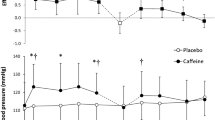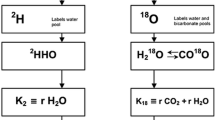Summary
Regular physical activity provokes numerous adaptations in the gastrointestinal tract and liver. It has been suggested that these changes may alter the pharmacokinetics of drugs in humans. We addressed this suggestion by measuring paracetamol pharmacokinetics in a group of healthy young males chosen to represent the widest possible range of habitual physical activity and food intake. Daily caloric intake in the 19 men, obtained from 3-day dietary records, ranged from 1680 to 5110 kcal (21 to 66 kcal/kg). Each volunteer ingested paracetamol 1000mg in the fasted, resting state in the morning; antecubital venous blood samples were analysed for the parent compound and its glucuronide and sulfate conjugates by high-performance liquid chromatography for 6 subsequent hours. We found no evidence that paracetamol pharmacokinetics vary with physical activity or with caloric intake: (a) for the parent compound, there was no correlation in maximum blood concentrations, half-life, total clearance, or area under the curve with individual caloric intake, and (b) when volunteers were divided a priori into more active and less active groups, or a posteriori into higher and lower calorie consumers (a 70% difference in daily caloric intake), these groups had identical plasma disappearance curves for paracetamol itself and for both of its metabolites. We conclude that the enormous variation among humans in long term physical activity and food intake fails to alter any aspect of the appearance or disappearance of paracetamol from blood.
Similar content being viewed by others
References
Carrió I, Estorch M, Serra-Grima R, et al. Gastric emptying in marathon runners. Gut 1989; 30: 152–5
Yiamouyiannis CA, Martin BJ, Watkins III JB. Chronic physical activity alters hepatobiliary excretory function in rats. J Pharmacol Exp Ther 1993; 265: 321–7
Yiamouyiannis CA, Sanders RA, Watkins III JB, et al. Chronic physical activity: hepatic hypertrophy and increased total bio-transformation enzyme activity. Biochem Pharmacol 1992; 44: 121–7
Martin BJ, Yiamouyiannis CA, Sanders RA. Exercise and hepatobiliary function. In: Siegers CP, Watkins III JB, editors. Biliary excretion of drugs and other chemicals. Stuttgart: Fischer Verlag, 1991: 497–509
Boel J, Anderson LB, Rasmussen B, et al. Hepatic drug metabolism and physical fitness. Clin Pharmacol Ther 1984; 36: 121–6
Ducry J-J, Howald H, Zysset T, et al. Liver function in physically trained subjects. Dig Dis Sci 1979; 24: 192–6
Frenkl R, Gyore A, Szeberenyi S. The effect of muscular exercise on the microsomal enzyme system of the rat liver. Eur J Appl Physiol 1980; 44: 135–40
Watkins III JB, Crawford ST, Sanders RA. Chronic voluntary exercise may alter hepatobiliary clearance of endogenous and exogenous chemicals in rats. Drug Metab Dispos 1994; 22: 537–43
Koltz U, Maier K, Fischer C, et al. Therapeutic efficacy of sulfasalazine and its metabolites in patients with ulcerative colitis and Crohn’s disease. N Eng J Med 1980; 303: 1499–502
Howie D, Adriaenssens P, Prescott LF. Paracetamol metabolism following overdosage: application of high performance liquid chromatography. J Pharm Pharmacol 1977; 29: 235–7
Albert KS, Sedman AJ, Wagner JG. Pharmacokinetics of orally administered acetaminophen in man. J Pharmacokin Biopharmaceut 1974; 2: 381–93
Dietz AJ, Carlson JD, Khalil SKW, et al. Effects of alcoholism on acetaminophen pharmacokinetics in man. J Clin Pharmacol 1984; 24: 205–8
Kelley MT, Walson PD, Edge JH, et al. Pharmacokinetics and pharmacodynamics of ibuprofen isomers and acetaminophen in febrile children. Clin Pharmacol Ther 1992; 52: 181–9
Lee WH, Kramer WG, Granville GE. The effect of obesity on acetaminophen pharmacokinetics in man. J Clin Pharmacol 1981; 21: 284–7
Rumble RH, Roberts MS, Denton MJ. Effects of posture and sleep on the pharmacokinetics of paracetamol (acetaminophen) and its metabolites. Clin Pharmacokinet 1991; 20: 167–73
Sahajwalla CG, Ayres JW. Multiple-dose acetaminophen pharmacokinetics. J Pharm Sci 1991; 80: 855–60
Yamaoka K, Nakagawa T, Uno T. Application of Akaike’s Information Criterion in the evaluation of linear pharmacoki-netic equations. J Pharmacokinet Biopharm 1978; 6: 165–75
D’Argenio DZ, Schumitzky A. ADAPT II: Interactive Mathematical Software for Pharmacokinetic/Pharmacodynamic Systems Analysis. Users Guide. Biomedical Simulations Resource, University of Southern California, Los Angeles, CA, 1990
Gibaldi M, Perrier D. Pharmacokinetics. New York: Marcel Dekker, 1982: 1–43
Day WW, Weiner M. Inhibition of hepatic drug metabolism and carbon tetrachloride toxicity in Fischer-344 rats by exercise. Biochem Pharmacol 1991; 42: 181–4
Passmore R, Durnin JGVA. Human energy expenditure. Physiol Rev 1955; 35: 801–40
Canas R, Romer JJ, Baldwin RL. Maintenance energy requirements during lactation in rats. J Nutr 1982; 112: 1879–80
Fausto N. Regulation of liver growth: protooncogenes and transforming growth factors. Lab Invest 1989; 60: 4–13
Mehta S, Nain CK, Yadav D, et al. Disposition of acetaminophen in children with protein calorie malnutrition. Int J Clin Pharmacol Ther Toxicol 1985; 23: 311–5
Petring OU, Adelhoj B, Ibsen M, et al. The relationship between gastric emptying of semisolids and paracetamol absorption. Br J Clin Pharmacol 1986; 22: 659–62
deMorais SM, Chou SY, Wells PG. Biotransformation and toxicity of acetaminophen in congenic RHA rats with or without a hereditary deficiency in bilirubin UDP-glu-curonosyltransferase. Toxicol Appl Pharmacol 1992; 117: 81–7
Gregus Z, Madhu C, Klaassen CD. Effect of microsomal enzyme inducers on biliary and urinary excretion of acetaminophen metabolites in rats. Drug Metab Dispos 1990; 18: 10–19
Villa JG, Collado PS, Almar MM, et al. Changes in the biliary excretion of organic anions following exhaustive exercise in rats. Biochem Pharmacol 1990; 40: 2519–24
Schauer JE, Schelin A, Hanson P, et al. Dehydroepiandrosterone and a beta-agonist, energy transducers alter antioxidant enzyme systems: influence of chronic training and acute exercise in rats. Arch Biochem Biophys 1990; 283: 503–11
Lew H, Quintanilha A. Effects of endurance training and exercise on tissue antioxidative capacity and acetaminophen detoxification. Eur J Drug Metab Pharmacokinet 1991; 16: 59–68
Grimby G. Renal clearances during prolonged supine exercise at different loads. J Appl Physiol 1965; 20: 1294–8
Lee JB, Katayama S. Inflammation and non-steroidal anti-inflammatory drugs. In: Smith CM, Reynard, AM, editors. Textbook of Pharmacology. Philadelphia: Saunders, 1992: 430–2
Author information
Authors and Affiliations
Rights and permissions
About this article
Cite this article
Yiamouyiannis, C.A., Harris, A., Sanders, R.A. et al. Paracetamol Pharmacokinetics are Independent of Caloric Intake and Physical Activity. Drug Invest 8, 361–368 (1994). https://doi.org/10.1007/BF03257451
Published:
Issue Date:
DOI: https://doi.org/10.1007/BF03257451




